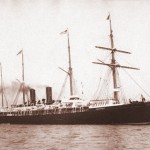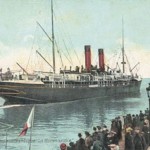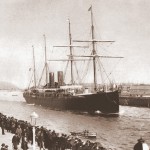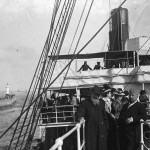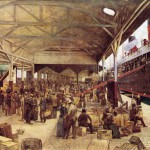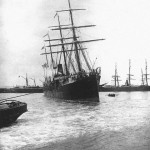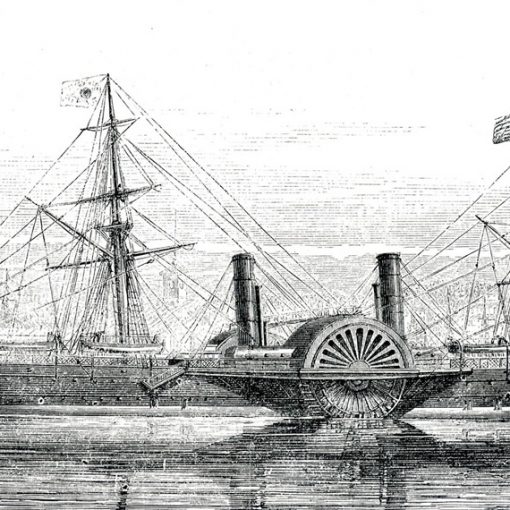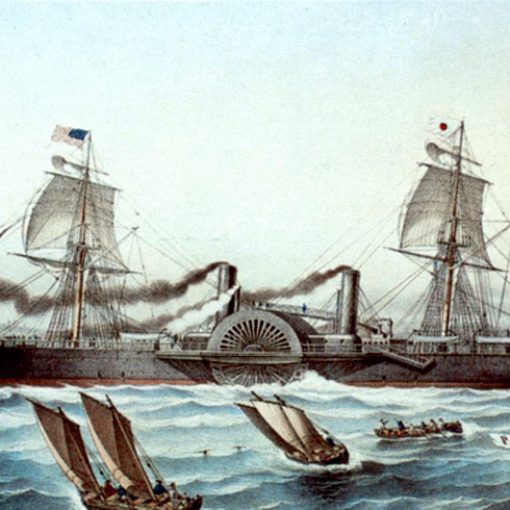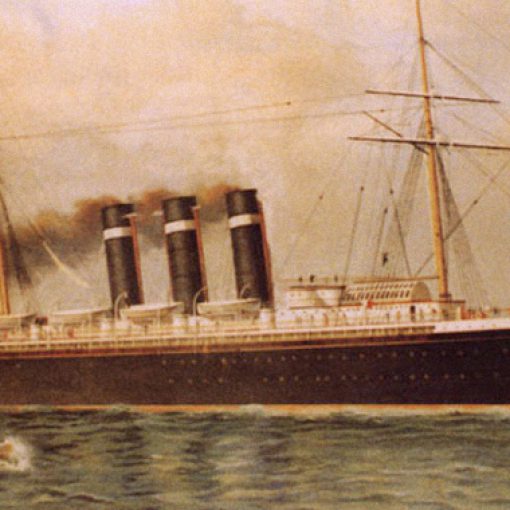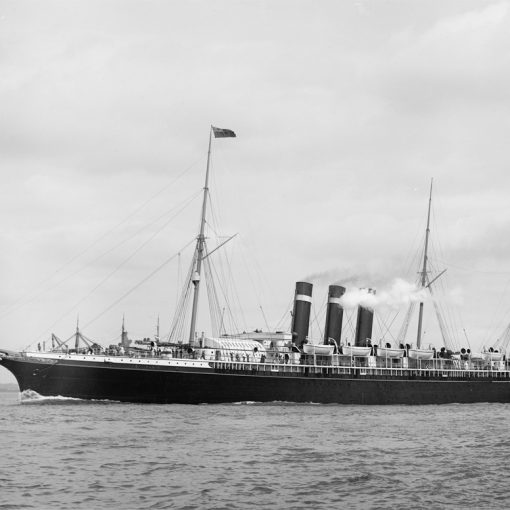1883 – 1911
Also known as Ville de New York and La Normandie
The French Line had started business back in 1854 as the Compagnie Générale Maritime. By 1861 the name had been changed to the much more familiar Compagnie Générale Transatlantique. CGT would become one of the world’s most famous and prestigious shipping companies. But the road towards achieving this goal was a long one, full of difficulties.
In 1862, CGT bought a Spanish vessel on the stocks, named her Lousiane and had thereby acquired the first ship of the company. By 1864 a new trio of sister ships entered service. They were the Washington, Lafayette and Europe. This trio was the first to cross the Atlantic under the French flag. A year later a bigger, improved version of the Washington-class entered service. The new trio’s first ship was the Impératrice Éugenie. She was followed by her sisters France and Nouveau Monde. The French Line had definitely become part of the most prestigious shipping clientele in the world. But one thing remained for CGT to conquer – the speed-race on the North Atlantic.
By the early 1880s the fastest liner in CGT had a service speed of a mere 12 knots. An acceptable speed for companies such as the British Cunard Line and White Star Line was somewhere around 15 knots. CGT decided to order a new ship to live up to the requirements on the oceans.
In 1882 the new vessel was laid down at Vicker’s Shipbuilding Company in Barrow-in-Furness in Great Britain. She was called Ville de New York. Progress continued during the year and by late October, time had come to launch the ship. She had a projected gross tonnage of over 6,000 tons – the largest ship in the Compagnie Générale Transatlantique. At the time of the launch, the vessel had been renamed Normandie. The liner should have a service speed of over 15 knots to put France in the race for the prestigious Blue Riband of the Atlantic.
The speed provided other benefits than prestige. The French Government agreed to renew CGT’s mail contract because of the Normandie’s speed. The annual subsidy was 5,480,000 French Francs. Shipping companies had realised long ago that profitable business was only possible with a mail contract from the Government.
The Normandie’s engines were indeed something special for the time. A safety precaution was installed, making the engines capable of running at a slow speed if one of them should fail to work. Many other liners had to stand still in such an event, or use old-fashioned sails if available.
On February 19th 1883 the Normandie was ready for her trials. During these she managed to reach a very impressive top speed of 17.25 knots. CGT was delighted and gladly received her from the builders in Britain on the 27th. The French Line had advertised their new liner keenly, and for the maiden departure to New York from Le Havre on May 5, 1,066 people were on the passenger list. Upon arrival in New York it was evident that Normandie would not be able to capture the Blue Riband from the Guion Line’s Alaska. Nevertheless, the Normandie had proved a worthy competitor on the North Atlantic and the French Line was more than happy with her.
The first major accident for the Normandie occurred in October the same year. When entering Le Havre after a crossing, she accidentally hit and sank the brig Alliance. Then the Normandie swung her bow away so quickly that it hit the Eastern Quay. Following this serious encounter, the CGT-liner was out of service until a new stem-girder could be available from Vicker’s Shipbuilding Company. On March 29, 1884, the girder had been delivered and put in place, and the Normandie could re-enter service. However, in December 1885 she was out of service again, but this time for boiler repairs. In a matter of months she was back on the Atlantic.
In 1886 a new set of CGT-liners entered service. They were the La Champagne, La Bourgogne, La Gascoigne and La Bretagne. These four vessels were to be teamed with the Normandie. As a consequence, French Line wanted the Normandie’s name changed so it would fit in with the others. The prefix ‘La’ was added to the name. Many people thought it strange to add ‘La’ instead of ‘Le’. After all, ships are of masculine gender in France. But as countries and provinces are of feminine gender, the French Academy persuaded CGT to give the ship the name La Normandie.
Yet another dreadful accident including La Normandie happened on January 23, 1892. When the liner was about to leave Le Havre she rammed and sank the tugboat Abeille 9. The accident demanded the life of nine crewmen from the tug. La Normandie had not escaped the collision unscathed either. Her bow damages was considerable enough to cancel the voyage to New York. She was sent to repair and soon she was back, plowing the seas.
In November the same year, La Normandie was brought to Cherbourg for conversion into an Auxiliary Cruiser with 7 x 5.5-inch guns. There was no war including France going on at the time, this was merely done for exercise. She was back into trans-Atlantic passenger service within a year.
A major refit was done to La Normandie in the winter between 1893-1894. She had her engines converted into triple expansion at the Penhoët shipyards. The conversion required the ship’s two funnels to be lengthened. They were also given horizontal tops, giving the vessel a new profile. Two of the four masts were removed making La Normandie resemble a true steamship, leaving the days of sail entirely behind. On April 21, 1894 she re-entered service. However, the schedule would look different for La Normandie in the future. She would only spend the summer months on the North Atlantic. During the winter months she would sail between Nazaire and Vera Cruz.
The last serious accident La Normandie had to go through took place a year later. In one of the ship’s coal bunkers a build-up of gas caused an explosion and a fire in the adjacent stokehold. Due to this, La Normandie missed the following voyage.
In 1897, the British Queen Victoria had sat on the throne for 60 years. Included in her Diamond Jubilee was a fleet review at Spithead with many guests. La Normandie was part of the French contribution as she honoured the elderly Queen with her presence.
Three years later, La Normandie was entirely removed from the North Atlantic, being solely dedicated to the St. Nazaire-Havana-Vera Cruz route. She continued here until she was put on a service between St. Nazaire and Panama in 1908. She remained until 1911 when she was considered too old. La Normandie made her last voyage on September 11th. She was officially taken out of service in October. The same year she was sold for 452,000 French Francs and was taken to Bo’ness, Fifth of Forth where she was scrapped.
Specifications
- 459 feet (142.1 m) long
- 48 feet (14.9 m) wide
- 6,283 gross tons
- Steam engines capable of 7,200 horsepower, powering a single propeller
- 15.75 knot service speed
- Passenger capacity of 1,109 people

